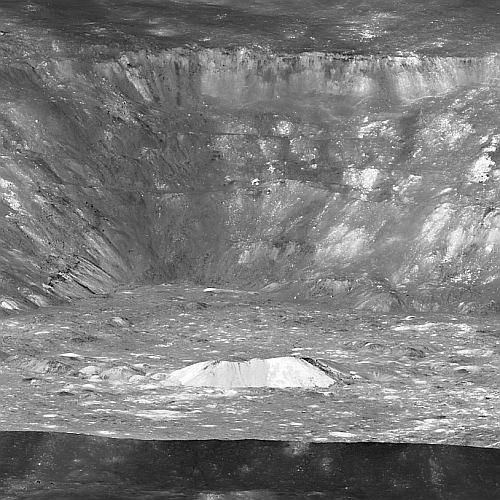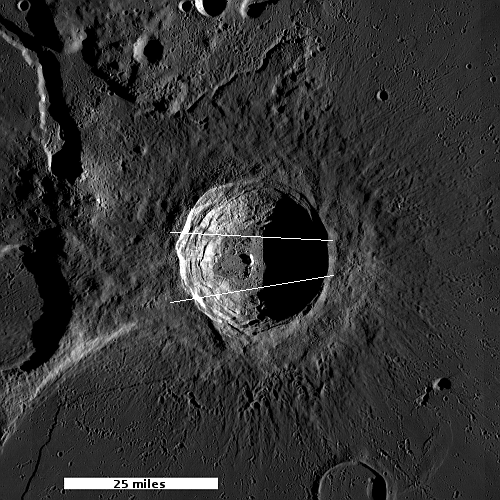The steep interior rim of Aristarchus Crater
Cool image time! The photo to the right, cropped, reduced, and sharpened to post here, is a just released image taken by Lunar Reconnaissance Orbiter, looking across the top of Aristarchus Crater on the Moon from a height of only 60 miles, with the dark surrounding plateau in the foreground contrasting sharply with the bright crater interior. For scale, the distance from the floor of the crater to the top of the rim is about 9,000 feet. The bright central peak is about 1,300 feet tall. The contrast in brightness inside and outside the crater is explained thus:
Adjacent to Aristarchus crater is the Aristarchus plateau, one of the largest volcanic centers on the Moon. Here we find one of the largest rilles [on the Moon, dubbed Vallis Schröteri], a massive pyroclastic deposit, and the source of extensive flood basalts.
These volcanic materials are considered relatively young (for the Moon) – 1.5 to 2.5 billion years. The pyroclastic deposit formed when magma was explosively ejected from the vent and broke into small droplets quenched as glass in the cold vacuum of space as they fell back to the surface. Due to their high glass content, the pyroclastic deposits are distinctly low in albedo (relatively dark), providing a dark background for the bright Aristarchus crater. Within the crater, some of these pyroclastic deposits may be visible as the darkest areas on the far wall, and glassy impact melt is moderately lower in reflectance than the bright, rocky materials exposed on areas of the crater floor and walls.
The overview map below shows both the crater and the vent from which Vallis Schröteri belched.
This view comes from an earlier LRO image inspecting the boulders on the floor of Aristarchus. The two white lines indicate approximately the area seen in the oblique view above. The beginning of the Vallis Schröteri, also nicknamed the Cobra’s Head by many astronomers, can be seen as the large dark canyon at center left. It begins at this point and meanders to the west for another 100 miles. That beginning point is a deep pit that is thought to be the vent from which the lava flowed. Its connection to Aristarchus is obvious, though the exact geological story remains unsolved.
Two other earlier cool images of Aristarchus can be viewed here and here. All illustrate the tragedy of the cancellation of the Apollo 18 mission in the 1970s, as that manned flight was going to land at this spectacular location.
On Christmas Eve 1968 three Americans became the first humans to visit another world. What they did to celebrate was unexpected and profound, and will be remembered throughout all human history. Genesis: the Story of Apollo 8, Robert Zimmerman's classic history of humanity's first journey to another world, tells that story, and it is now available as both an ebook and an audiobook, both with a foreword by Valerie Anders and a new introduction by Robert Zimmerman.
The print edition can be purchased at Amazon or from any other book seller. If you want an autographed copy the price is $60 for the hardback and $45 for the paperback, plus $8 shipping for each. Go here for purchasing details. The ebook is available everywhere for $5.99 (before discount) at amazon, or direct from my ebook publisher, ebookit. If you buy it from ebookit you don't support the big tech companies and the author gets a bigger cut much sooner.
The audiobook is also available at all these vendors, and is also free with a 30-day trial membership to Audible.
"Not simply about one mission, [Genesis] is also the history of America's quest for the moon... Zimmerman has done a masterful job of tying disparate events together into a solid account of one of America's greatest human triumphs."--San Antonio Express-News
Cool image time! The photo to the right, cropped, reduced, and sharpened to post here, is a just released image taken by Lunar Reconnaissance Orbiter, looking across the top of Aristarchus Crater on the Moon from a height of only 60 miles, with the dark surrounding plateau in the foreground contrasting sharply with the bright crater interior. For scale, the distance from the floor of the crater to the top of the rim is about 9,000 feet. The bright central peak is about 1,300 feet tall. The contrast in brightness inside and outside the crater is explained thus:
Adjacent to Aristarchus crater is the Aristarchus plateau, one of the largest volcanic centers on the Moon. Here we find one of the largest rilles [on the Moon, dubbed Vallis Schröteri], a massive pyroclastic deposit, and the source of extensive flood basalts.
These volcanic materials are considered relatively young (for the Moon) – 1.5 to 2.5 billion years. The pyroclastic deposit formed when magma was explosively ejected from the vent and broke into small droplets quenched as glass in the cold vacuum of space as they fell back to the surface. Due to their high glass content, the pyroclastic deposits are distinctly low in albedo (relatively dark), providing a dark background for the bright Aristarchus crater. Within the crater, some of these pyroclastic deposits may be visible as the darkest areas on the far wall, and glassy impact melt is moderately lower in reflectance than the bright, rocky materials exposed on areas of the crater floor and walls.
The overview map below shows both the crater and the vent from which Vallis Schröteri belched.
This view comes from an earlier LRO image inspecting the boulders on the floor of Aristarchus. The two white lines indicate approximately the area seen in the oblique view above. The beginning of the Vallis Schröteri, also nicknamed the Cobra’s Head by many astronomers, can be seen as the large dark canyon at center left. It begins at this point and meanders to the west for another 100 miles. That beginning point is a deep pit that is thought to be the vent from which the lava flowed. Its connection to Aristarchus is obvious, though the exact geological story remains unsolved.
Two other earlier cool images of Aristarchus can be viewed here and here. All illustrate the tragedy of the cancellation of the Apollo 18 mission in the 1970s, as that manned flight was going to land at this spectacular location.
On Christmas Eve 1968 three Americans became the first humans to visit another world. What they did to celebrate was unexpected and profound, and will be remembered throughout all human history. Genesis: the Story of Apollo 8, Robert Zimmerman's classic history of humanity's first journey to another world, tells that story, and it is now available as both an ebook and an audiobook, both with a foreword by Valerie Anders and a new introduction by Robert Zimmerman.
The print edition can be purchased at Amazon or from any other book seller. If you want an autographed copy the price is $60 for the hardback and $45 for the paperback, plus $8 shipping for each. Go here for purchasing details. The ebook is available everywhere for $5.99 (before discount) at amazon, or direct from my ebook publisher, ebookit. If you buy it from ebookit you don't support the big tech companies and the author gets a bigger cut much sooner.
The audiobook is also available at all these vendors, and is also free with a 30-day trial membership to Audible.
"Not simply about one mission, [Genesis] is also the history of America's quest for the moon... Zimmerman has done a masterful job of tying disparate events together into a solid account of one of America's greatest human triumphs."--San Antonio Express-News



